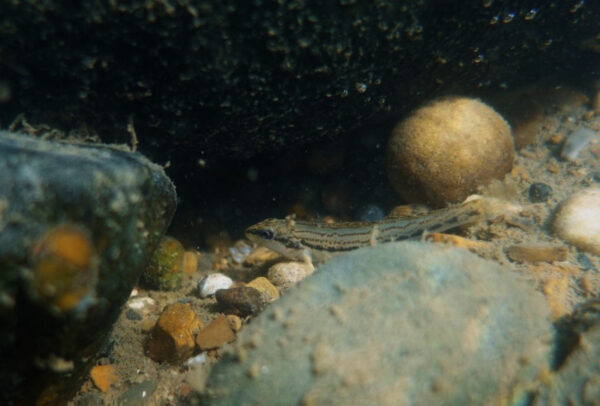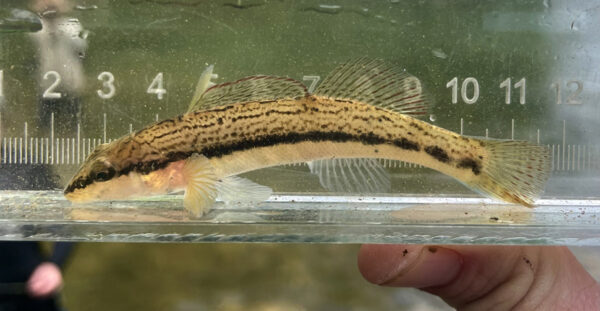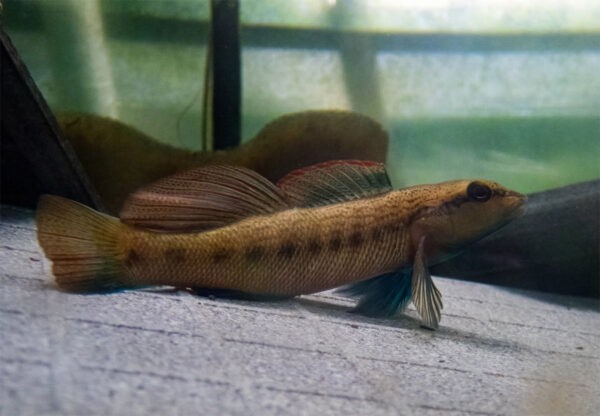An up-close look at an Ashy Darter in its environment. Photo by ©Derek Wheaton
A fisheries biologist displays a large adult Ashy Darter. Photo by ©Fletcher Stone
Fact File
Scientific Name: Allohistium cinereum
Classification: Fish, Order Perciformes, Family Percidae
Conservation Status:
- Species of Greatest Conservation Need-Tier 1b on the Virginia Wildlife Action Plan
Size: Ashy Darters average about 2.75 inches in length
Life Span: Ashy Darters live for about 4 years
Distribution
The Ashy Darter is endemic to the Clinch River of southwest Virginia.

Identifying Characteristics

An Ashy Darter in a viewing tank. Photo by ©Maddie Cogar – DWR
- Spots concentrated above the lateral line
- Oblique bars along the side
- Second dorsal is much higher than the first dorsal in adults
- Cheek, opercle, and belly are scaled
- Caudal fin is truncate to slightly emarginate
Percidae Characteristics and Anatomical Terms


Illustrations by ©Makayla DeVivo – DWR
Habitat
Like other species of darter the Ashy Darter is a benthic species of fish and thrives in the interstitial spaces between cobbles and boulders along the river bottom. They require clean, unimpaired water and prefer shallow pools with aquatic vegetation.

An Ashy Darter at home on the stream-bottom. Photo by ©Maddie Cogar – DWR
Diet
The Ashy Darter primarily feeds upon aquatic insects such as midges, mayflies, and worms.
Reproduction
The Ashy Darter typically reaches sexual maturity at two years of age and spawns in the spring. Females produce up to 250 adhesive eggs which they deposit onto aquatic vegetation for the male to fertilize.

An Ashy Darter being viewed in a small aquarium. Photo by ©Ryan Sonier
Threats
- Sedimentation due to poor land-use practices and/or development
- Water quality impairment
- Fragmentation due to stream barriers such as culverts and dams
- Competition with other species
- Predation from non-native species
Conservation Efforts
The Ashy Darter was considered extirpated from Virginia in 1967 due to point-source pollution occurring within the Clinch River. Nearly four decades later biologists discovered a single male individual. In subsequent follow-up surveys in 2005 biologists were able to locate two additional female Ashy Darters from the same location.
Due to funding provided through State Wildlife Grants (SWG) the Virginia Department of Wildlife Resources has been able to facilitate work with partners in restoring the Ashy Darter population within the Clinch River watershed. Through these restoration and monitoring efforts, the Ashy Darter is now found at several locations within the Clinch River watershed.

Conservation Fisheries Incorporated (CFI) has played an important role in the restoration of many species of fishes in the southeast U.S. This Ashy Darter is one of the species propagated by CFI for reintroduction purposes. Photo by ©Derek Wheaton
Last updated: September 21, 2025
The Virginia Department of Wildlife Resources Species Profile Database serves as a repository of information for Virginia’s fish and wildlife species. The database is managed and curated by the Wildlife Information and Environmental Services (WIES) program. Species profile data, distribution information, and photography is generated by the Virginia Department of Wildlife Resources, State and Federal agencies, Collection Permittees, and other trusted partners. This product is not suitable for legal, engineering, or surveying use. The Virginia Department of Wildlife Resources does not accept responsibility for any missing data, inaccuracies, or other errors which may exist. In accordance with the terms of service for this product, you agree to this disclaimer.

